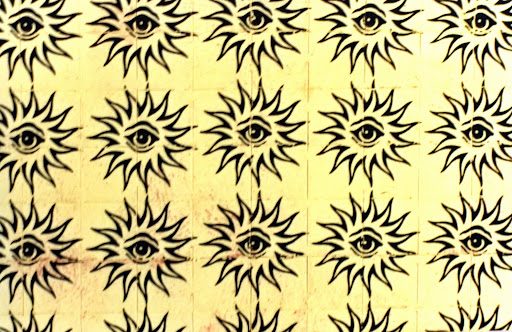Answer: Because it was the first commercially successful collection of psychedelic rock on a major label.
Yeah, there were psychedelic rumblings in other parts of the country that were notable in their own right. And yeah, I know, commercial success shouldn't be an indicator of a record's value. But sometimes marketability really matters, and that's the case here. The Byrds had a high profile as a successful folk-pop group. They were a friendly, smiling group with pleasant music that was popular on AM radio stations. They were on TV. They sold a lot of records. You can see where I'm going with this... friendly, popular, pleasant... and then BOOM. Like sneaking a party in through the back door, they dared to follow through on a new kind of music they believed in. They explored the fringes for the rest of us, and their major label distribution tapped an unprecedented audience. But that's enough about the social import, let's talk about the music.
Fifth Dimension has been called a transitional album because of the band's new found artistic control and spirit of experimentation, both accomplished within a pop song format. Fans of psychedelic pop music by Kevin Ayres, Pink Floyd, the Beau Brummels, the Pretty Things or the Beatles should take to this material very easily. The lineup is the same as before, minus Gene Clark. But the result is such a departure from the previous two albums that it feels like a whole new band. Indeed, with Crosby and McGuinn taking the helm, it almost was. Most notably, and thankfully, there isn't a single Bob Dylan cover. I like the Byrds' Dylan covers just fine, they're excellent, but when I listen to those first two records, for every Dylan cover, I can't stop thinking of at least one original Byrds tune that doesn't exist.
The side 1 opener "5D (Fifth Dimension)" sets the bar for the rest of the set. Its lyrics join the hands of faith and reason, explaining our universe through the Einsteinian lens, with grateful acceptance of its divine creator. As McGuinn related in So You Want to be a Rock and Roll Star, "5D was an ethereal trip into metaphysics, into an almost Moslem submission to an Allah, an almighty spirit, free-floating, the fifth dimension being the 'mesh' which Einstein theorized about. He proved theoretically - but I choose to believe it." The band's fans interpreted the lyrics as drug related, which caused an outcry and several bans from radio play. No publicity is bad publicity, right? The song's detractors only fueled its ascent, and it reached #44 on Billboard's Hot 100 -- a testament to the endurance of the new, more thoughtful variety of rock and roll that was being born.
"Mr. Spaceman," somewhat of a throwaway single upon the first listen, is one of my favorite Byrds tracks. It has been retained by McGuinn and is still part of his live repertoire. He claims Crosby didn't think the song should make the final cut because it wouldn't make any money. He thought his rocker "Hey Joe" was a better bet for a single. Thankfully, Crosby lost that argument. Its humorous lyrics describe nocturnal visitations by extraterrestrial life forms, and after insisting he is a peaceful being, the narrator pleads with them to take him off of the Earth. This is a pretty serious song. We Earthlings like to think no one can see us, that we're out here on the edge of the Milky Way all by our lonesome selves. But what if that wasn't true? Considering the spiritual sentiments expressed in "5D," the lyrics of "Hey Mr. Spaceman" take on a new tone. Consider your neighbors might live next door to your planet, too, and treat everyone as a member of the same family. You were created, you are never alone, and truth is but one point which is multiplied by fools..
"Eight Miles High" is another charting single with some killer guitar work by McGuinn. His intro lick and freakout solo are an attempt to play modally as John Coltrane was doing at that time. The guitar has its characteristic overdriven and clear ringing tone. McGuinn says it was a feat of production, running the guitar signal through a compressor before entering it directly into the board. Otherwise, as anyone who picks up a Ric will tell you, the guitar's tone is a resounding thud with little of the sustain integral to the Byrds' appeal. More of such droning, atonal psychedelic rock can be found in "What's Happening?!?!" Crosby penned the tune, which asks the immortal question of why anything exists. The sentiment expressed in the lyrics are interesting to me as an illustration of the differences between McGuinn and Crosby, the former having already answered the question posed by the latter.
A final note: if you read my review and you also read Richie Unterberger's review on the dreaded All Music website, please ignore Mr. Unterberger's comments about how uneven the record is. So much criticism is a fine bit of hindsight but it says nothing for the other merits of the album that outweigh any problems of selection or sequencing. Fifth Dimension is still fun to listen to and it stands as a benchmark recording that was made in a hurry under special circumstances. It's very important as the transition between ephemeral pop simplicity and the deeper waters of a new musical style that would grow to have long lasting and cross-generational appeal. Please enjoy.



